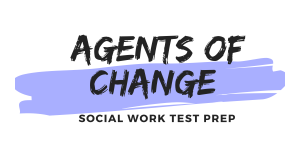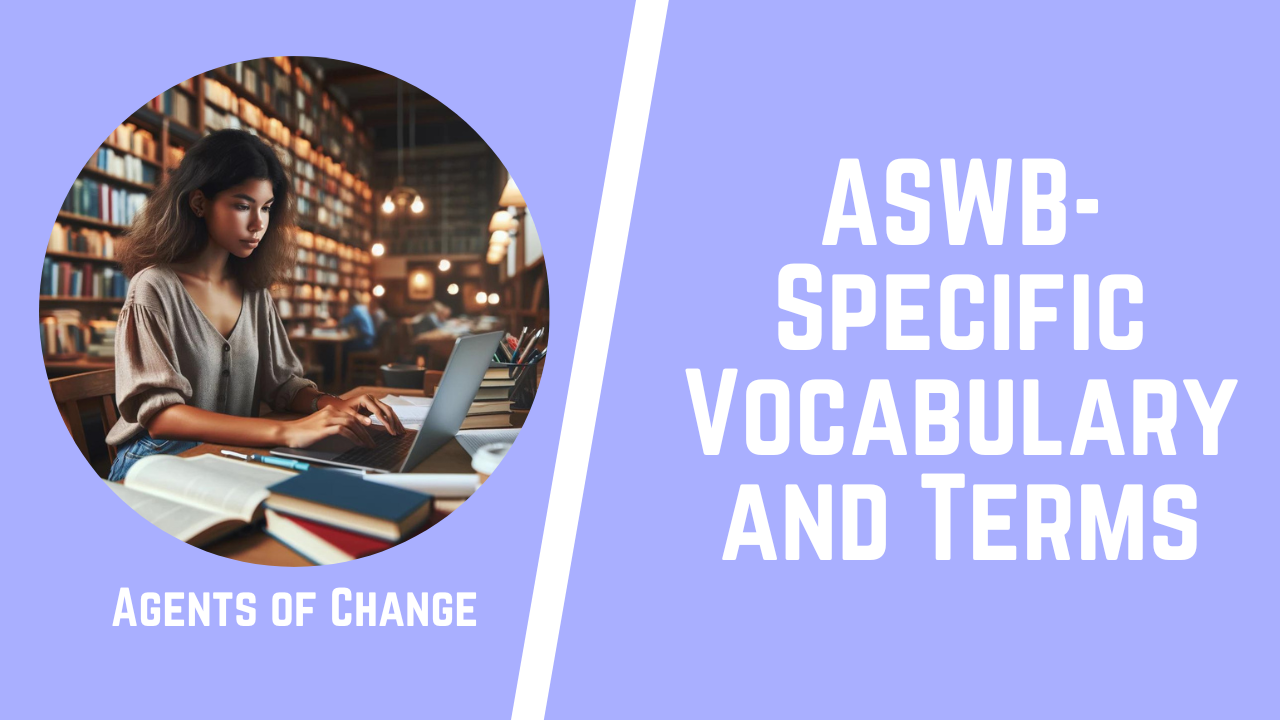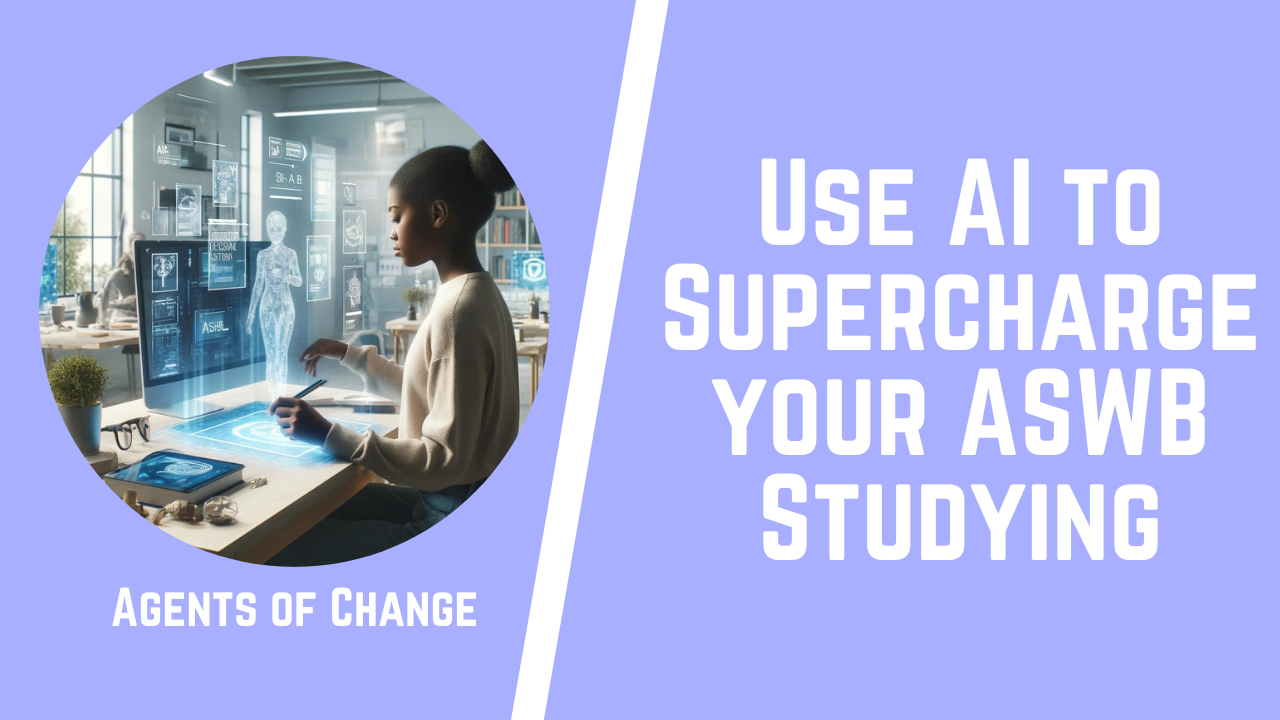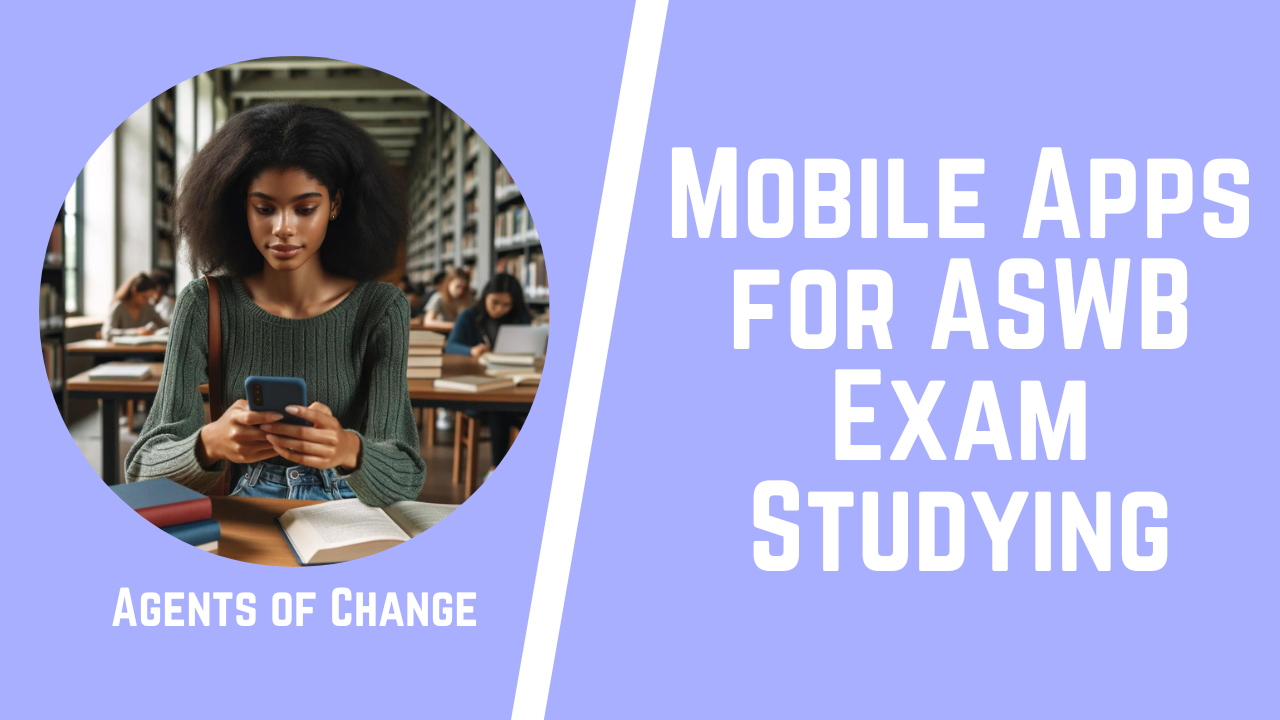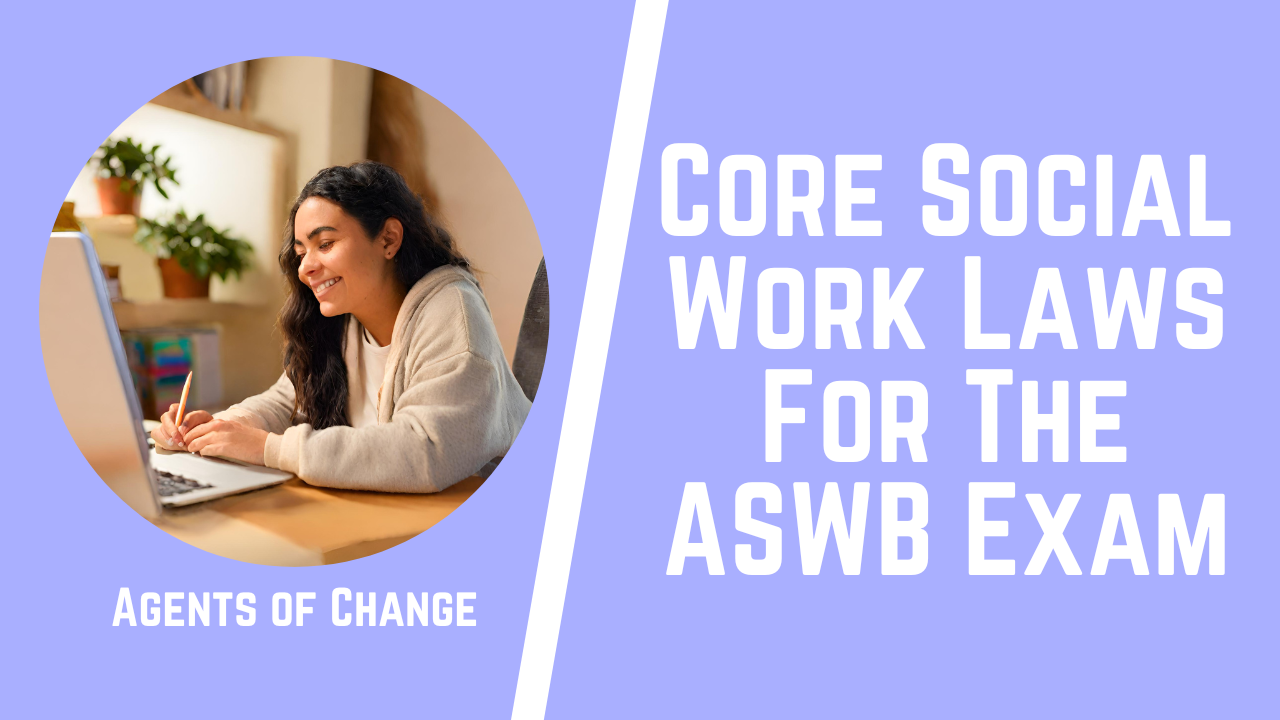Are you gearing up for the ASWB exam and feeling a bit jittery about those “FIRST” questions? Worry not! You’re about to embark on an educational journey that will turn those nerves into confident strides toward success.
In this article, we’re going to unravel the mysteries of answering “FIRST” questions on the ASWB exam, inspired by the tactics shared in our Breaking Down Questions with the 5 W’s blog post and video.
Learn more about the ASWB exam and create a personalized ASWB study plan with Agents of Change. We’ve helped thousands of Social Workers pass their ASWB exams and want to help you be next!
1) Breaking Down Questions Using the 5 W’s Strategy
Your strategy in dissecting questions on the LCSW, LMSW, and LSW ASWB exams is a pivotal factor in your success. Having an effective approach to the exam’s complex questions is essential.
What kinds of questions are featured in the ASWB exam?
- Recall Questions: These require you to remember specific facts or concepts.
- Application Questions: Here, you need to remember basic information and use it in a case scenario or a real-world context.
- Reasoning Questions: These are often the toughest. They demand not only remembering and applying information but also integrating it, scrutinizing details, and solving problems.
How do the 5 W’s aid in deconstructing ASWB questions?
- Who: Identifies the client involved.
- What: Determines the main issue, the question’s focus, and the Social Worker’s necessary actions.
- Where: Pinpoints the location or setting of the scenario and where the client is situated.
- When: Establishes the timeline, such as the first meeting with the client, the onset of symptoms, or the start of the problem.
- Why: Seeks reasons for requiring a Social Worker’s assistance and interprets clues provided in the question.
Discover how to leverage the 5 W’s technique and other methods to break down various ASWB question types in this video.
2) The Art of Tackling “FIRST” Questions
Let’s deep dive into the art of tackling those “FIRST” questions on the ASWB exam.
Step 1: Understanding the Scenario
- Read Carefully: Don’t just skim through the question. Actively read and absorb every detail.
- Highlight Key Information: Identify crucial elements like the client’s situation, immediate needs, or ethical dilemmas.
- Context Matters: The setting of the question can give you clues. Is it in a clinical setting, a school, or a community?
Step 2: Rule Out the Obvious No-Nos
- Red Flags: Some answers might violate ethical guidelines or legal standards. These are immediate no-gos.
- Too Good to Be True: If an option seems overly simplistic for a complex issue, it’s probably not the right choice.
Step 3: The Battle of the Bests
- Ethical Standards: Keep the NASW Code of Ethics in mind. What would be the most ethical first step? Learn more about the Code of Ethics in our blog post.
- Safety First: If the scenario involves risk or harm, prioritize answers that address safety.
- Client-Centered Approach: The best answer often involves what’s best for the client, respecting their autonomy and dignity.
Step 4: The Final Countdown
- Process of Elimination: Narrow down your choices by discarding the least likely options.
- Trust Your Training: Rely on what you’ve learned. Your education and intuition are powerful tools.
- Stay Calm: Don’t rush. Take a moment to breathe and then select the answer that feels most aligned with best practices.
Extra Tips for Mastery
- Practice Scenarios: Work through practice questions. The more you practice, the better you’ll get at identifying the right “FIRST” step. Agents of Change programs include hundreds of practice questions including many “FIRST” questions.
- Understand the Why: Don’t just memorize answers. Understand why an answer is correct.
- Discuss with Peers: Sometimes talking through questions with others can open up new perspectives and deepen your understanding. All Agents of Change programs include 2 live study groups per month.
Learn more about the 5 W’s strategy to break down questions and additional tips and tricks for the ASWB exam with Agents of Change
3) Section-by-Section Strategies
Tackling “FIRST” questions on the ASWB exam requires a nuanced understanding of various Social Work topics. Let’s break down strategies for different sections, ensuring you’re well-equipped for whatever the exam throws your way.
Ethics and Boundaries
This section is crucial as it tests your understanding of ethical practices and professional boundaries.
- Identify the Ethical Principle: Questions often revolve around core ethical principles like confidentiality, informed consent, or dual relationships. Pinpoint which principle is at play.
- Legal Considerations: Always weigh the legal implications of your actions. Legal requirements often dictate the ‘first’ step in a scenario involving legal issues.
- Safety First: If a question involves potential harm to the client or others, prioritize actions that ensure safety.
Assessment and Intervention
In these questions, you’re usually asked to identify the first step in assessing a client’s needs or in planning an intervention.
- Gathering Information: The first step often involves understanding the client’s situation, history, and current needs.
- Building Rapport: Sometimes, the first step is to establish a relationship with the client. Trust is key in Social Work.
- Prioritize Urgent Needs: In crisis situations, the first step is often addressing immediate safety or stabilization.
Cultural Competence
Questions in this section test your ability to work effectively across diverse cultural backgrounds.
- Cultural Sensitivity: Look for answers that demonstrate respect and understanding of the client’s cultural background.
- Avoid Assumptions: The first step should never be based on stereotypes or generalizations.
- Inclusivity in Approach: Ensure the chosen action does not marginalize or alienate the client based on their cultural identity.
Social Work Practice and Theory
These questions assess your understanding of various social work models and theories.
- Theory Application: Determine which Social Work theory or model is most applicable to the scenario.
- Client-Centered Approach: The best first action often involves empowering the client, supporting their autonomy, and utilizing strengths-based approaches.
Policy and Advocacy
Here, you might encounter questions about the first step in advocating for policy changes or working within policy frameworks.
- Policy Analysis: Understand the policy’s impact on the client and the community.
- Advocacy Steps: The first step might involve gathering information, building coalitions, or raising awareness about the issue.
Research and Supervision
These questions can revolve around the initial steps in conducting research or supervising Social Work interns.
- Research Ethics: In research-related questions, the first step often involves ensuring ethical practices.
- Supervisory Role: When supervising, the first action might be setting clear expectations, establishing boundaries, or understanding the supervisee’s learning style.
Lifelong Learning
The ASWB exam also assesses your commitment to ongoing professional development.
- Continued Education: Sometimes, the first step involves acknowledging gaps in your knowledge and seeking additional training or supervision.
- Reflective Practice: In scenarios involving mistakes or learning opportunities, the first step might be self-reflection or consultation with colleagues.
Agents of Change programs include 2 live study groups each month and hundreds of practice questions on key ASWB topics.
4) FAQs – Answering “FIRST” Questions on the ASWB Exam
Q: What are the best strategies for approaching “FIRST” questions on the ASWB Exam?
A: “FIRST” questions can be challenging, but with the right approach, they become manageable:
- Understand the Scenario: Carefully read the question to grasp the context and specifics of the scenario.
- Prioritize Safety and Ethics: Safety and ethical considerations often guide what should be done first.
- Use the Process of Elimination: Discard options that are clearly not immediate actions or that violate ethical guidelines.
- Consider Client-Centered Approach: Think about what step respects the client’s dignity, autonomy, and provides the most benefit to their situation.
Q: How do I differentiate between options in “FIRST” questions that seem very similar?
A: Differentiating between similar options requires a keen eye:
- Focus on Key Words: Look for subtle differences in wording that might make one option more immediately relevant or appropriate than another.
- Hierarchy of Needs: Consider Maslow’s hierarchy of needs or similar frameworks to determine which action is most fundamental in the given scenario.
- Contextual Clues: Sometimes, the broader context of the question provides hints about the most appropriate first action.
- Professional Standards: Reflect on standard practices and guidelines in Social Work. Often, the correct answer aligns with these standards.
- Seek Second Opinions: Discussing these questions with peers or mentors can provide new insights that help distinguish between similar options.
Q: I often struggle with “FIRST” questions. How can I overcome this challenge and improve my performance?
A: Improving in this area involves targeted practice and reflection:
- Analyze Your Approach: After answering practice questions, review your thought process. Did you understand the question correctly? Did you consider all relevant factors?
- Learn from Mistakes: When you get a question wrong, delve into the reasoning behind the correct answer. Understanding your mistakes is key to improvement.
- Simulate Exam Conditions: Practice under timed conditions to get used to making quick, yet informed decisions.
- Study Group Discussions: Discussing these questions in study groups can expose you to different perspectives and reasoning strategies.
- Regular Review: Regularly revisit concepts and ethics in Social Work to reinforce your foundational knowledge, aiding in better decision-making for these questions.
5) Conclusion
Mastering the art of answering “FIRST” questions on the ASWB Exam is an important step towards achieving success in your Social Work licensing journey.
It’s important to remember that these questions are designed to test your knowledge and assess your critical thinking, ethical reasoning, and decision-making skills in real-world scenarios.
Learn more about the ASWB exam and create a personalized ASWB study plan with Agents of Change. We’ve helped thousands of Social Workers pass their ASWB exams and want to help you be next!
6) Practice Question – ASWB Exam – “FIRST”
A Social Worker is meeting with a new client who has been referred for symptoms of severe anxiety and stress. The client mentions feeling overwhelmed and is having difficulty articulating their thoughts and concerns. What should be the Social Worker’s FIRST action in this initial session?
A) Begin a detailed assessment of the client’s mental health history and potential anxiety triggers.
B) Introduce cognitive-behavioral techniques to help the client manage their anxiety symptoms.
C) Create a safe and supportive environment to help the client feel comfortable and build rapport.
D) Refer the client to a psychiatrist for a medication evaluation due to the severity of their symptoms.
Correct Answer: C) Create a safe and supportive environment to help the client feel comfortable and build rapport.
Rationale: The correct answer is C. The first and foremost action in the initial session with a client, especially one who is feeling overwhelmed and having difficulty articulating their thoughts, is to create a safe and supportive environment. This helps in establishing trust and rapport, which are critical for effective therapeutic engagement and intervention. It’s important for the client to feel heard, understood, and comfortable in sharing their experiences and concerns.
Option A, beginning a detailed assessment immediately, might be too invasive for a first session, especially when the client is already feeling overwhelmed. Option B, introducing cognitive-behavioral techniques, is premature before establishing rapport and fully understanding the client’s situation. Option D, referring the client to a psychiatrist for a medication evaluation right away, may be necessary later but is not the appropriate first action before understanding more about the client’s situation and establishing a therapeutic relationship. Therefore, creating a supportive environment (Option C) is the most appropriate first step.
————————————————————————————————————————————————
► Learn more about the Agents of Change course here: https://agentsofchangeprep.com
About the Instructor, Meagan Mitchell: Meagan is a Licensed Clinical Social Worker and has been providing individualized and group test prep for the ASWB for over five years. From all of this experience helping others pass their exams, she created the Agents of Change course to help you prepare for and pass the ASWB exam!
Find more from Agents of Change here:
► Facebook Group: https://www.facebook.com/groups/aswbtestprep
► Podcast: https://anchor.fm/agents-of-change-sw
#socialwork #testprep #aswb #socialworker #socialwork #socialworktest #socialworkexam #exam #socialworktestprep #socialworklicense #socialworklicensing #licsw #lmsw #lcsw #aswbexam #aswb #lcswexam #lmswexam #aswbtestprep #aswbtest #lcswtestprep #lcswtest #lmswtestprep #lmswtest #aswbcourse #learningstyles #learningstyle
Disclaimer: This content has been made available for informational and educational purposes only. This content is not intended to be a substitute for professional medical or clinical advice, diagnosis, or treatment
